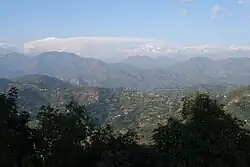Palpa District
Palpa District (Nepali: पाल्पा जिल्लाⓘ, a part of Lumbini Province, is one of the seventy-seven districts of Nepal, a landlocked country of South Asia. The district, with Tansen as its headquarters, covers an area of 1,373 km2 (530 sq mi) and has a population (2011) of 261,180.[1]
Pālpā District
पाल्पा जिल्ला | |
|---|---|
 Mahabharat Range near Tansen. The High Himalayas are barely visible in the snow and cloud. | |
 | |
| Country | |
| Province | Lumbini Province |
| Admin HQ. | Tansen |
| Government | |
| • Type | Coordination committee |
| • Body | DCC, Pālpā |
| • Head | Santosh Lal Shrestha (Congress) |
| Area | |
| • Total | 1,373 km2 (530 sq mi) |
| Population (2011) | |
| • Total | 261,180 |
| • Density | 190/km2 (490/sq mi) |
| Time zone | UTC+05:45 (NPT) |
| Telephone Code | 075 |
| Website | Official Website |
Palpa District is not far from Pokhara and easily reached by bus. Palpa was the seat of the Hindu Sen kingdom that ruled over this region from the 16th century for almost 300 years so Headquarter of Palpa is called "Tansen" (Nepali: तानसेन)
Geography and climate
| Climate Zone[2] | Elevation Range | % of Area |
|---|---|---|
| Lower Tropical | below 300 meters (1,000 ft) | 0.3% |
| Upper Tropical | 300 to 1,000 meters 1,000 to 3,300 ft. |
51.3% |
| Subtropical | 1,000 to 2,000 meters 3,300 to 6,600 ft. |
47.3% |
Demographics
At the time of the 2011 Nepal census, Palpa District had a population of 261,180.
As their first language, 61.9% spoke Nepali, 34.3% Magar, 2.0% Newari, 0.6% Kumhali, 0.3% Bote, 0.2% Urdu, 0.1% Bhojpuri, 0.1% Hindi, 0.1% Tharu and 0.1% other languages.[3]
Ethnicity/caste: 52.6% were Magar, 17.5% Hill Brahmin, 7.8% Chhetri, 6.7% Kami, 3.4% Newar, 3.2% Sarki, 2.6% Kumal, 1.9% Damai/Dholi, 1.4% Thakuri, 0.6% Gharti/Bhujel, 0.4% Musalman, 0.3% Bote, 0.3% other Dalit, 0.2% Gurung, 0.1% Badi, 0.1% Gaine, 0.1% Kathabaniyan, 0.1% Sanyasi/Dasnami, 0.1% Tharu and 0.2% others.[4]
Religion: 90.5% were Hindu, 7.8% Buddhist, 0.9% Christian, 0.5% Muslim, 0.2% Prakriti and 0.1% others.[5]
Literacy: 76.0% could read and write, 2.5% could only read and 21.4% could neither read nor write.[6]
| Census year | Pop. | ±% p.a. |
|---|---|---|
| 1981 | 214,442 | — |
| 1991 | 236,313 | +0.98% |
| 2001 | 268,558 | +1.29% |
| 2011 | 261,180 | −0.28% |
| 2021 | 242,423 | −0.74% |
| Source: Citypopulation[7] | ||
Local bodies
Major rivers and khola
- Kali Gandaki River
- Tinau Khola
- Ridi Khola
- Purwa Khola
- Jhumsa Khola
- Dovan River
- Barabisse khola
- Dumre Khola
Major lakes
- Satyawati Lake (990m above sea level)
- Pravas Lake
- Sita Kunda
Gallery
 Gandaki River Valley in Palpa
Gandaki River Valley in Palpa Gandaki River Valley in Palpa
Gandaki River Valley in Palpa Ranighat Palace
Ranighat Palace Mahabharat Range, Lesser Himalaya
Mahabharat Range, Lesser Himalaya Mountains around Tansen
Mountains around Tansen Glades around Tansen
Glades around Tansen View of Palpa Madifaat ( rice field) & Damkada City during summer time
View of Palpa Madifaat ( rice field) & Damkada City during summer time Map of Palpa District
Map of Palpa District
Places of attraction
- Argali Palace was constructed by Juddha Shamsher
- Forts like Kalika fort, Nuwakot fort, Bakumgadi Fort are historic place of attraction
- Mahamritunjaya Statue of Lord Shiva situated at Barangdi which is the biggest in Asia among metal statue of Lord Shiva
- Rambha Devi Temple a religious place 31 km (19 mi) east of Tansen in Tahu VDC.
- Ramdi is a religious place in the bank of Kali Gandaki River. On 1 Baisakh, there is a festival in this area.
- Ranighat Palace (Ranimahal) is also called Tajmahal of Nepal due to similar stories behind the construction of this palace. It was constructed by General Khadka for her wife Tejkumari in 1893 AD.
- Rishikesh Complex of Ruru Kshetra Hindu pilgrimage and cremation site
- Rishikesh Temple was built by the King Manimukunda Sen. According to Hindu mythology, this is the place where some part of body of Satidevei was cremated. It hosts a festival which occurs in 1st of Magh month when hidus come to take bath in Kali Gandaki River.
- Shrinagar Hill is spot for viewing high Himalayas. Dhawalagiri, Tukuche, Nilgiri, Annapurana, Himchuli and other mountains can be viewed from this place.
- Tansen is a historic city with palaces, temples, stupas and historic architecture.
- Vhairabsthan Temple is a Shiva temple with huge trident, believed to be largest in Asia.
- Madanpokhara is known its vegetable farmings and viewing great Madi Valley.
Villages
See also
References
- "2011 Nepal census (National Report)" (PDF). Central Bureau of Statistics. Government of Nepal. Archived from the original (PDF) on 2013-05-25. Retrieved November 22, 2013.
- The Map of Potential Vegetation of Nepal - a forestry/agroecological/biodiversity classification system (PDF), Forest & Landscape Development and Environment Series 2-2005 and CFC-TIS Document Series No.110., 2005, ISBN 87-7903-210-9, retrieved November 22, 2013
- NepalMap Language
- NepalMap Caste
- NepalMap Religion
- NepalMap Literacy
- "NEPAL: Administrative Division". www.citypopulation.de.
- "Districts of Nepal". Statoids.